Self-driving cars or autonomous cars are revolutionary automobiles that require no or little human interaction and control, allowing us to safely travel and transport goods with comfort like never before.
This is possible by implementing different technologies such as sensors, cameras, computer vision, artificial intelligence, and other software processing.
Although the concept may seem futuristic, self-driving cars are already in the late testing phase conducted by numerous companies worldwide. In just a couple of years, I am confident they will be on the streets and become the next big thing of the 21st century.
Hence, this technology is something we should be familiar with, especially if you want one of the most lucrative careers in a skyrocketing industry.
Software engineers at leading self-driving car companies can earn as high as $160000 or even more in the US. For example, according to Glassdoor, those at Waymo make $171188 yearly on average.
Fortunately, you can kickstart your journey through high-quality online courses. They will help you thoroughly understand the technology behind these revolutionary automobiles and get valuable hands-on experience that you can develop further upon.
This article will do the heavy lifting for you by featuring only the best courses. You can then freely select the right one according to your preferences and budget without hassles.
Affiliate Disclosure: This article from Victory Tale contains affiliate links. We will receive a small commission from course providers if you purchase self-driving car courses through them.
However, we always value integrity and prioritize our audience’s interests. You can then rest assured that we will present each course truthfully.
Things You Should Know
Types of Courses and Prerequisites
All courses on this list are not for absolute beginners. You will need good background knowledge in the following:
- Some programming experience (preferably Python or C++)
- Probability & Statistics (ideally, statistics for data science)
- Linear Algebra
Self-driving car courses in this article will be in two groups. The first is for beginners, while the second is for experienced software developers, data scientists, or data engineers who want to get into the autonomous vehicle industry.
Hence, if you already have years of experience in software development, data science, or machine learning, you should start with an advanced course, which is more fast-paced, intense, and in-depth, saving hours of your valuable time.
Such advanced courses have additional prerequisites as follows:
- Solid object-oriented programming skills in any language (Python or C++ is still preferred, though)
- College-level calculus
- Machine Learning, Deep Learning, Reinforcement Learning (not always required, but possessing the knowledge would be a big plus.)
- Decent Hardware: Since you need to run the CARLA simulator effectively in all advanced courses, you will need certain hardware specifications (the information will be provided on each program page.)
Criteria
Below are the criteria for the best self-driving car courses.
- Credible instructor with years of experience in the self-driving car industry or relevant industries
- User-friendly learning platform
- Most course content is up-to-date.
- Abundant high-quality course materials
- Provide excellent value for money (not cash-grab courses)
- Mostly positive reviews from actual students
- My personal experience with the course, instructor, and platform (if any) must be positive.
I will update this article quarterly. If any course on this list fails to meet the criteria, I will remove them immediately.
Beginner-level Courses
1. Intro to Self-Driving Cars Nanodegree Program
Udacity is unarguably the best platform for steadfast students to learn everything IT. This Nanodegree program provides crucial insights on self-driving vehicles’ functionality and equips you with practical project-building skills. Hence, you will be able to proceed to a more advanced course with ease.
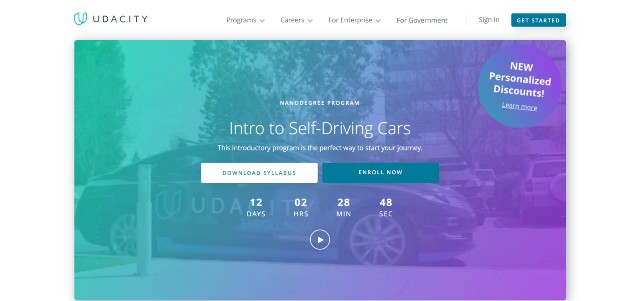
Course Content
The program comprises seven minor courses as follows:
1. Bayesian Thinking – The first course will drill deep into Bayesian Inference, the framework that allows self-driving cars to understand their surroundings. You will also learn about localization and tracking algorithms, enabling you to perceive the world as an autonomous car does.
2. Working with Matrices – The second course will discuss object-oriented programming (OOP) and linear algebra. You will learn the concepts and understand steps to use classes and implement various algorithms on your project.
3. C++ Basics – The third course is pretty straightforward. You will learn C++ fundamentals and perceive how to translate a Python program to a C++ one.
4. Performance Programming in C++ – As a sequel to the third course, you will learn to write quality code or optimize poorly written ones according to best practices.
5. Navigating Data Structures – Data structures and algorithms are essential for creating self-driving cars. Thus, you will learn all relevant concepts and use them to plan an optimal path for your virtual autonomous vehicles.
6. Visualizing Calculus and Controls – The sixth course starts with essential calculus, which will help you understand the “continuous” nature of the world. Later on, you will use Python libraries to visualize trajectories in the real world to issue vehicle-control commands.
7. Machine Learning and Computer Vision – The final course is a deep dive into crucial computer vision concepts. You will learn how to use machine learning to teach machines to identify images and objects and the surrounding environment correctly.
The curriculum is comprehensive. You will learn all the fundamentals you need to effectively kickstart your journey.
My favorite part is the real-world project available in each course. For example, you will create a tool to visualize trajectories and another to perform classification tasks reliably. Therefore, you will have sufficient opportunities to practice and learn independently by trial and error.
Udacity recommends spending 10 hours per week on the program, and you will complete it in four months.
I think the suggested pace is intense. However, you can adjust your own pace at will. Just keep in mind that the more time you spend on the program, the higher the tuition fees (see below).
Support
Once you enroll in the program, you will gain access to three types of student support as follows.
Technical Mentor Support – You can use the ticketing system to ask mentors questions at any time (available 24/7). In most cases, you will receive a reply within less than an hour, which is far faster than any other online course.
This support is beneficial if you get stuck since it smoothens your learning process, eliminating any frustration of waiting hours, days, or even weeks for the instructor’s assistance.
Project Reviews – You can request experienced reviewers to provide feedback on your projects. These experts will give personalized feedback, additional tips & tricks, and inform you about the best practices.
Since there are no limits on the number of requests you can send, you can ask experts to review your work no matter you are at any stage of the project. Thus, you can learn from your mistakes and ensure that you are on the right track.
The turnaround time is approximately 1-3 hours, which is again very swift. You can leverage it to create a healthy feedback loop that aids your learning.
Career Services – Like web development bootcamps, Udacity offers a career service. The team will review your resume, LinkedIn profile, and Github portfolio to optimize them for job applications.
This service is a big plus. It guarantees that you properly showcase your skills to potential employers, thus drastically increasing your chance of receiving interview invitations and lucrative job offers from top companies.
Pricing
All Udacity programs use a subscription-based pricing model. This program costs $249 per month.
Alternatively, you can choose to pay for four months at once and receive a 15% discount for each, lowering tuition fees to $211 per month.
However, Udacity frequently offers discounts and financial support. Each can be as high as 40% off. It is possible to enroll in this excellent program by paying only $100 per month.
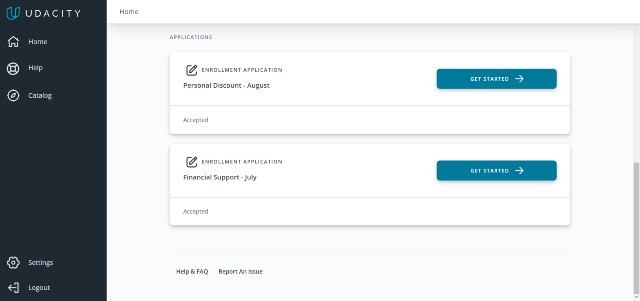
Furthermore, as of 2024, Udacity’s subscription is worth getting more than ever, as it provides complete access to the rest of the catalog. Thus, you can enroll in multiple nanoprograms simultaneously.
Pros & Cons
Pros
- Learn from a team of top experts who have years of experience in the industry
- Comprehensive: equipping you with all the skills you need to proceed to more advanced courses
- Well-structured, step-by-step curriculum
- Informative, balanced lessons
- Self-paced learning
- Include as many as seven challenging projects and numerous other assignments
- Timely mentor support
- Unlimited project reviews + career services
- Udacity frequently updates its content. Thus, the course content is rarely outdated.
Cons
- Expensive compared to other alternatives
- The suggested pace may be too intense for those with full-time employment.
2. The Complete Self-Driving Car Course – Applied Deep Learning
Suppose you are looking for a more affordable alternative to the above Udacity program. In that case, this top-rated Udemy course from a team of veteran software developers and mechanical engineers (Rayan Slim, Amer Sharaf, Jad Slim, and Sarmad Tanveer) may be your best bet.
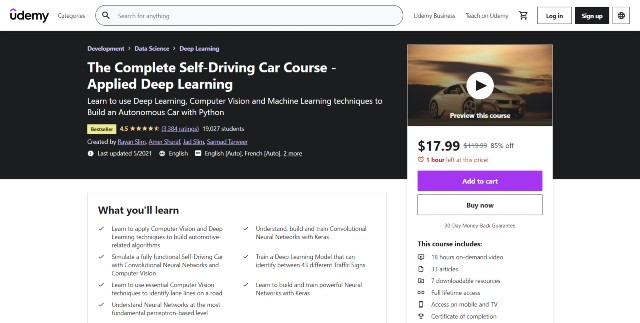
Course Content
Below is a summary of what you will learn from this video course.
- Python and NumPy crash course
- Machine Learning reviews
- Use computer vision via OpenCV to identify lane lines
- Keras and deep neural networks
- Multiclass Classification & MNIST Image Recognition
- Convolutional Neural Networks (CNNs)
- Traffic Sign Classification
- Behavioral Cloning
This video course is 18-hour long. Besides the lessons, you will have an opportunity to perform various tasks on your own, including training neural networks to identify real-world traffic signs.
Overall, this course is not as in-depth as Udacity’s program, but you will learn all the essential stuff at a highly affordable price. Therefore, this course is excellent for beginners to test the waters before investing money in a more expensive program.
Reviews: 4.5/5.0, Students: 19000+
Pros & Cons
Pros
- Beginner-friendly
- Cover all essential concepts in a concise manner
- Easy-to-follow curriculum
- Bite-sized lessons with clear explanations and examples
- Lifetime Access + 30-day money-back guarantee
- Affordable ($20 or lower when on sale)
Cons
- Some of the code provided in the course is now outdated.
- Students believe the exercises are too few.
- The course name is misleading, as it does not drill deep into advanced stuff at all.
3. Autonomous Cars: Deep Learning and Computer Vision in Python
This Udemy course is another promising option if you are looking for affordable training for basic autonomous driving development. It will cover all the fundamental technologies behind self-driving cars and the necessary tools that allow companies to build them.
You will learn from Frank Kane and Dr. Ryan Ahmed. Both are machine learning specialists with more than a decade of experience in the field.
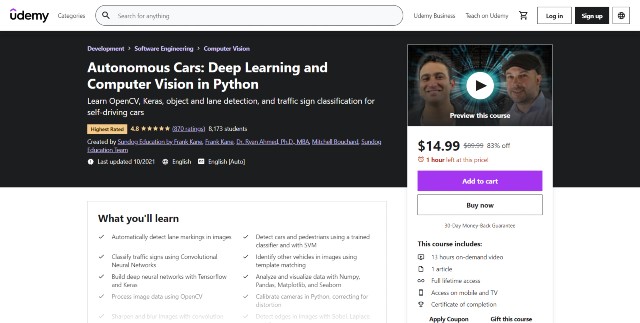
Course Content
A summary of the course content is as follows:
- Environment Setup + Python Crash Course
- Computer Vision Basics (OpenCV, Lane detection, image transformation, object detection)
- Introduction to Machine Learning
- Artificial Neural Networks (ANNs)
- Deep Learning and Tensorflow
The video content is 13-hour long, effectively summarizing all the relevant topics and explaining how to use popular tools such as OpenCV. However, it will not delve too deeply into complicated concepts.
In other words, you will not learn to build self-driving vehicles in this course. It is more about all elements that make them feasible.
This course is still helpful since it helps you understand the concepts fast and painlessly, providing a solid foundation for your next step in becoming a self-driving car engineer.
Also, business leaders and those who want to take this course as a hobby might find it the best available, because all explanations are in layman English, thus effortless to understand.
My favorite part about this course is that each section has numerous short practical assignments to complete. Thus, you will have abundant opportunities to practice in a realistic environment.
Reviews: 4.8/5.0, Students: 8100+
Pros & Cons
Pros
- Beginner-friendly
- Learn from two highly knowledgeable instructors
- Concise explanations of topics using layman English
- Learn about all the technologies and tools that make self-driving cars feasible
- Include numerous activities for students to gain hands-on experience
- Lifetime access + 30-day money-back guarantee
- Affordable ($20 or lower when on sale)
Cons
- Some students believe they need more explanations in particular areas.
- Barely touching advanced content
4. Self-Driving Cars with Duckietown
This excellent edX course from ETH Zurich will guide you through the process of programming and building self-driving cars using the Duckietown Robotic Ecosystem, an open-source platform created by MIT’s CSAIL.
Unlike all other courses on the list, this one will teach you to build a basic but actual self-driving car. However, you will need to invest in hardware costing $399. If you don’t want to do so, you can stick with the programming part.
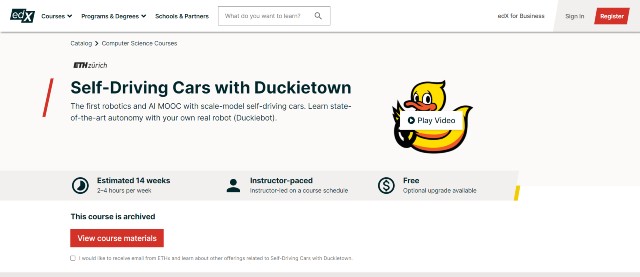
Course Content
Below is a summary of what you will learn in the course.
- Essential Robot Subsystems (Sensing, Actuation, Computation, etc.) and their functions
- Program Duckiebot to drive in arbitrary user-specified paths
- Program Duckiebot to perform autonomous decision making according to traditional or modern methods
- Image Processing
- Program Duckiebot to drive in empty road lanes and recognize obstacles
- Program Duckiebot to make it drive down roads with pedestrian duckies safely
You can take all these lessons with no hardware investment. However, if you want to continue further below, you will need a MOOC Founder’s Edition Kit, which costs $399.
- Assemble a Duckiebot and Duckietown
- Remotely operate your Duckiebot
It would be optimal to spend 2-4 hours per week on the course, and you will complete it in 14 weeks.
Auditing this course is free. However, if you want your assignments to be graded, you will need to enroll in the verified track, which costs $50 one-time.
Pros & Cons
Pros
- Build an actual self-driving car
- Learn from faculty members of a leading European university
- Well-structured curriculum
- Project-based learning
- Free auditing
Cons
- Optimally, you will need to invest in hardware, which is quite expensive.
Advanced Self-Driving Cars Courses
5. Self Driving Car Engineer Nanodegree Program
Created in partnership with Waymo and Mercedes-Benz, this brand-new program from Udacity aims to advance learners’ skills in building autonomous vehicles.
You will learn all the advanced technologies that leading companies utilize to power the latest generation of self-driving cars. Once you complete the program, you will be ready to apply for various positions in the industry.
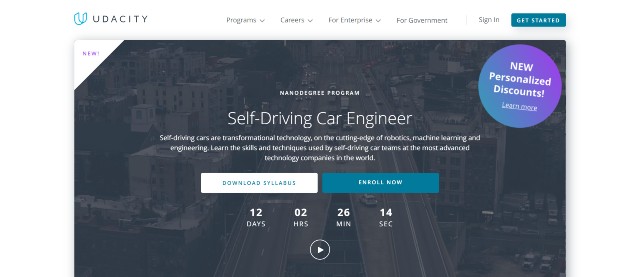
Course Content
This program consists of five minor courses as follows:
1. Computer Vision – You will first learn about the machine learning workflow commonly used in autonomous vehicle engineering. Later on, you will use TensorFlow to train convolutional neural networks that can identify and classify objects in images.
2. Sensor Fusion – The second course will deep dive into sensors. You will learn about the lidar sensor, the working principle, and how to choose suitable sensor types for self-driving cars.
Later on, you will use deep learning to detect objects in a 3D lidar point cloud and evaluate the model’s performance.
3. Localization – The third course will discuss localization in detail. You will learn about the bicycle motion model and Markov localization.
Subsequently, you will understand how to implement two scan matching algorithms, Iterative Closest Point (ICP), and Normal Distributions Transform (NDP)
4. Planning – The fourth course will go through all three stages of path planning. You will grasp how engineers route a vehicle from one point to another and handle emergencies.
In the second part of the course, you will generate a safe trajectory for self-driving cars in a highly realistic driving environment.
5. Control – The final course will explain how to control the self-driving car. You will grasp how to activate a throttle and command the vehicle to move along your planned trajectory.
In addition, you will learn the basic feedback control principle and how to apply it to autonomous vehicles.
Apart from the lessons, each minor course has challenging assignments and real-world projects for students to complete. For instance, you will design a PID controller to perform vehicle trajectory tracking and test its efficiency on the CARLA simulator.
Regarding the pace, Udacity suggests spending 10 hours per week on the program, and you will complete it in 5 months. However, you can set up your learning schedule at will since the program is self-paced.
From an overall perspective, I think this Udacity program is one of the very few online courses that drill deep into advanced self-driving car technology. Thus, if you want to pursue a career in this field, I highly recommend enrolling in this program.
Support and Pricing
You will receive the same level of support as the first program on this list: Technical Mentor Support, Project Reviews, and Career Services.
The tuition fees are also the same ($399 per month or $339 if you pay for five months at once.) You can also use Udacity’s sitewide discounts to lower tuition fees to $100 monthly.
Pros & Cons
Pros
- Unarguably one of the best online courses to learn advanced self-driving car concepts
- Learn the stage of the art of autonomous vehicle development from a team of experts working at leading self-driving car companies
- Well-structured curriculum
- In-depth, informative lessons with practical examples
- Numerous challenging assignments and real-world projects to complete: You will be using several tools commonly used by experts.
- Excellent student support (Mentor Support, Project Reviews, and Career Services)
Cons
- Costlier than other alternatives
6. Self-Driving Cars Specialization
This Coursera Specialization from the University of Toronto is another excellent alternative if you want to learn the advanced structure and components of a self-driving car software stack.
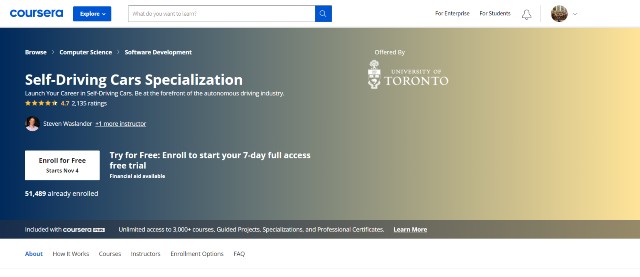
Course Content
The specialization comprises four minor courses as follows.
1. Introduction to Self-Driving Cars – The first course will introduce you to the fundamental concepts of self-driving cars. You will learn about the terminology, design considerations, and safety assessments in detail.
2. State Estimation and Localization- The second course will focus on sensors and how to use them in state estimation and localization for autonomous driving.
Later, you will develop models for typical localization sensors and apply several tools to fuse multiple sensor streams into a single state estimate.
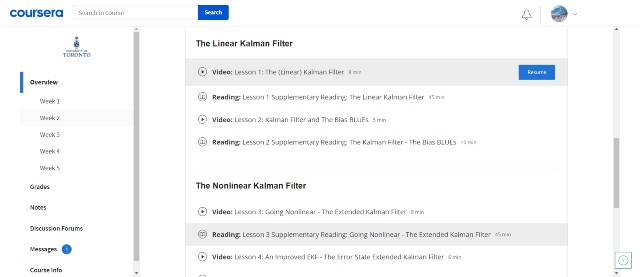
3. Visual Perception – The third course will drill deep into object detection through computer vision techniques. You will design and build convolutional neural networks to detect & identify objects and perform semantic segmentation for drivable surface estimation.
4. Motion Planning – The final course will discuss several planning tasks, including mission planning, behavioral planning, and local planning.
You will learn to use finite state machines to select the safest paths to execute and design the proper specifications for your cars to drive safely and obey traffic laws.
In all minor courses, you will have opportunities to gain practical experience by working on real-world projects. For example, you will write code to control a self-driving car around a racetrack in the CARLA simulation environment.
You should spend 5 hours per week on the courses, and you will finish them in seven months.
With regards to pricing, you can audit the program for free, but if you want graded assignments and a digital certificate, you need to pay $79 per month in program fees.
Pros & Cons
Pros
- Learn from professors of a leading Canadian university
- Well-structured curriculum
- Drill deep into advanced and practical self-driving car development concepts
- Include several real-world projects to obtain hands-on experience
- Free auditing
Cons
- Students believe the assignments are too challenging, while the explanations in the lectures are too simple for them to complete the quizzes.
- Almost no student support
Relevant Topics
Below are lists of courses on relevant topics that you may find helpful in learning autonomous vehicle development.
Machine Learning – Machine learning is foundational knowledge for developing AI tools and driverless cars.
Deep Learning – A branch of machine learning methods, allowing us to train advanced neural networks
Reinforcement Learning – Another area of machine learning that aims to train machines to take optimal action to maximize a cumulative reward, undoubtedly crucial for developing self-driving vehicles
Computer Vision – Self-driving cars will not be feasible without computer vision technology that allows machines to gain a high-level understanding of the surroundings